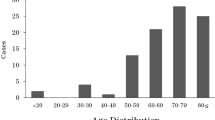Abstract
Fungal keratitis is a worldwide-distributed refractory and potentially blinding ocular infection caused by various fungi. It is necessary to investigate the etiological and epidemiological characteristics of this disease and establish a rapid and specific pathogenic identification method. Here, we isolated and identified fungal pathogens of 275 patients with presumed fungal keratitis from Jilin Province, China, and conducted statistical analyses of epidemiological information. The positive rate of fungal culture was 72.0 %. Fusarium sp. was the most common genus among 210 fungal isolates. The predominant species were Fusarium solani, Aspergillus fumigatus, and Candida glabrata, which accounted for over 50 % of the isolated organisms. Corneal trauma and previous use of drugs were the most important predisposing factors. In addition, a multiplex polymerase chain reaction (PCR) was designed with species-specific primers of the three species that could identify them with amplicons of approximately 330 bp from F. solani, 275 bp from A. fumigatus, and 230 bp from C. glabrata. Additionally, PCR with fungal universal primers and multiplex PCR were performed using DNA prepared by an improved DNA extraction method from corneal scrapings. With this method, fungal pathogens from corneal scrapings could be specifically and rapidly identified within 8 h. The culture-independent rapid identification of corneal scrapings may have great significance for the early diagnosis and treatment of fungal keratitis.





Similar content being viewed by others
References
Vengayil S, Panda A, Satpathy G, et al. Polymerase chain reaction-guided diagnosis of mycotic keratitis: a prospective evaluation of its efficacy and limitations. Invest Ophthalmol Vis Sci. 2009;50:152–6.
Thomas PA, Kaliamurthy J. Mycotic keratitis: epidemiology, diagnosis, and management. Clin Microbiol Infect. 2013;19:210–20.
Shukla PK, Kumar M, Keshava GB. Mycotic keratitis: an overview of diagnosis and therapy. Mycoses. 2008;51:183–99.
Thomas PA. Current perspectives on ophthalmic mycoses. Clin Microbiol Rev. 2003;16:730–97.
Thomas PA. Fungal infections of the cornea. Eye (Lond). 2003;17:852–62.
Sirikul T, Prabriputaloong T, Smathivat A, Chuck RS, Vongthongsri A. Predisposing factors and etiologic diagnosis of ulcerative keratitis. Cornea. 2008;27:283–7.
He D, Hao J, Zhang B, et al. Pathogenic spectrum of fungal keratitis and specific identification of Fusarium solani. Invest Ophthalmol Vis Sci. 2011;52:2804–8.
Wang L, Yokoyama K, Miyaji M, Nishimura K. Mitochondrial cytochrome b gene analysis of Aspergillus fumigatus and related species. J Clin Microbiol. 2000;38:1352–8.
Kalkanci A, Ozdek S. Ocular fungal infections. Curr Eye Res. 2011;36:179–89.
Shah A, Sachdev A, Coggon D, Hossain P. Geographic variations in microbial keratitis: an analysis of the peer-reviewed literature. Br J Ophthalmol. 2011;95:762–7.
Tu EY, McCartney DL, Beatty RF, Springer KL, Levy J, Edward D. Successful treatment of resistant ocular fusariosis with posaconazole (SCH-56592). Am J Ophthalmol. 2007;143:222–7.
Chowdhary A, Singh K. Spectrum of fungal keratitis in North India. Cornea. 2005;24:8–15.
Galarreta DJ, Tuft SJ, Ramsay A, Dart JK. Fungal keratitis in London: microbiological and clinical evaluation. Cornea. 2007;26:1082–6.
Gower EW, Keay LJ, Oechsler RA, et al. Trends in fungal keratitis in the United States, 2001 to 2007. Ophthalmology. 2010;117:2263–7.
Zhong WX, Sun SY, Zhao J, Shi WY, Xie LX. Retrospective study of suppurative keratitis in 1054 patients. Zhonghua Yan Ke Za Zhi. 2007;43:245–50.
Xie L, Zhong W, Shi W, Sun S. Spectrum of fungal keratitis in north China. Ophthalmology. 2006;113:1943–8.
Shi W, Wang T, Xie L, et al. Risk factors, clinical features, and outcomes of recurrent fungal keratitis after corneal transplantation. Ophthalmology. 2010;117:890–6.
Tuft SJ, Tullo AB. Fungal keratitis in the United Kingdom 2003–2005. Eye (Lond). 2009;23:1308–13.
Sengupta J, Khetan A, Saha S, Banerjee D, Gangopadhyay N, Pal D. Candida keratitis: emerging problem in India. Cornea. 2012;31:371–5.
Chakrabarti A, Singh R. The emerging epidemiology of mould infections in developing countries. Curr Opin Infect Dis. 2011;24:521–6.
Ghosh A, Basu S, Datta H, Chattopadhyay D. Evaluation of polymerase chain reaction-based ribosomal DNA sequencing technique for the diagnosis of mycotic keratitis. Am J Ophthalmol. 2007;144:396–403.
Bu R, Sathiapalan RK, Ibrahim MM, et al. Monochrome Light Cycler PCR assay for detection and quantification of five common species of Candida and Aspergillus. J Med Microbiol. 2005;54:243–8.
Esposto MC, Cogliati M, Tortorano AM, Viviani MA. Determination of Cryptococcus neoformans var. neoformans mating type by multiplex PCR. Clin Microbiol Infect. 2004;10:1092–4.
Acknowledgments
This study was supported by grants from the National Natural Science Foundation of China (No. 30910103903), the Important National Science & Technology Specific Projects of China (No. 2013ZX10004612-006), and the grant from the Science and Technology Department of Jilin Province, China (No. 20130522014JH). We thank Professor Koji Yokoyama (Medical Mycology Research Center of Chiba University, Japan) for his help and guidance. And there is no conflict of interests to declare.
Author information
Authors and Affiliations
Corresponding author
Ethics declarations
Conflict of interest
The authors declare that they have no conflict of interest.
Rights and permissions
About this article
Cite this article
He, D., Hao, J., Gao, S. et al. Etiological Analysis of Fungal Keratitis and Rapid Identification of Predominant Fungal Pathogens. Mycopathologia 181, 75–82 (2016). https://doi.org/10.1007/s11046-015-9950-x
Received:
Accepted:
Published:
Issue Date:
DOI: https://doi.org/10.1007/s11046-015-9950-x




